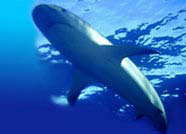


Tiger shark

 |
 |
 |
|||
| Home | Evolution
| Classification
| Glossary | Biology
| Behavior | Shark
Repellent | Shark
Conservation | Do's &
Don'ts | Did You Know?
Tiger shark |
 |
||||
|
 Scientific
Name: Galeocerdo cuvier Scientific
Name: Galeocerdo cuvierThe tiger shark has tiger-like markings on a dark back with an off-white underbelly. Pups have spotted markings that grow together to form stripes that fade with maturity. It has a large, thick-body with a blunt snout. The first dorsal fin is much longer than the second. The caudal fin is long and pointed. There is a dermal ridge along the back between the 2 dorsal fins. Color-Adult: gray-brown on top, off-white belly, young shark: dark stripes on the back. Tiger sharks have a special gill slit (a spiracle) behind the eyes that provide oxygen flow directly to the eyes and brain. It also has a very good sense of smell, electroreceptors sensitive to electric currents in the water, and keen eyesight. Tiger shark teeth are very serrated (saw-edged), razor-sharp, and curved. The teeth are the same in upper and lower jaws. The teeth are located in rows which rotate into use as needed. The first two rows are used in obtaining prey, the other rows rotate into place as they are needed. As teeth are lost, broken, or worn down, they are replaced by new teeth that rotate into place. Tiger sharks will eat fish, turtles, crabs, clams, mammals, sea birds, reptiles, other sharks, and  just about anything else that they can catch alive. Because of this habit,
they are also referred to as garbage cans of the sea. True scavengers,
their stomachs have been found to contain fish, turtles, other sharks,
sea snakes, lobsters, as well as inorganic objects such as tin cans, beer
bottles, rubber tyres and overcoats. One was even reputed to contain a
chicken coop with bones and feathers still inside.
just about anything else that they can catch alive. Because of this habit,
they are also referred to as garbage cans of the sea. True scavengers,
their stomachs have been found to contain fish, turtles, other sharks,
sea snakes, lobsters, as well as inorganic objects such as tin cans, beer
bottles, rubber tyres and overcoats. One was even reputed to contain a
chicken coop with bones and feathers still inside.The tiger shark does occasionally attack people and is greatly feared, but people are not sought out by sharks. Tiger sharks are solitary animals except during mating. The female gives birth to between 10 and 80 pups, which are completely independent from birth. Tiger sharks go from the surface to 1,200 feet (340 m). They swim in tropical waters worldwide and in some temperate seas. They inhabit both the shoreline and open waters, ranging perhaps up to 500 miles. They are found worldwide in warm seas (tropical and subtropical). Tiger sharks swim at an average speed of 2.4-mph (3.85 kph). They can swim in fast bursts, but can only sustain these high speeds for a few seconds. They can live for around 12-13 years. Tiger sharks are not considered to be endangered although they are hunted for sport and for their meat, fins and liver oil. Statistics: The largest recorded was 7.4m (24ft), but on average, females are 3.75m and males are 3m. Tiger Shark Classification:
|
|||||
| Sitemap | Reach To Us | Jimtrade - Business Directory of India | |||||